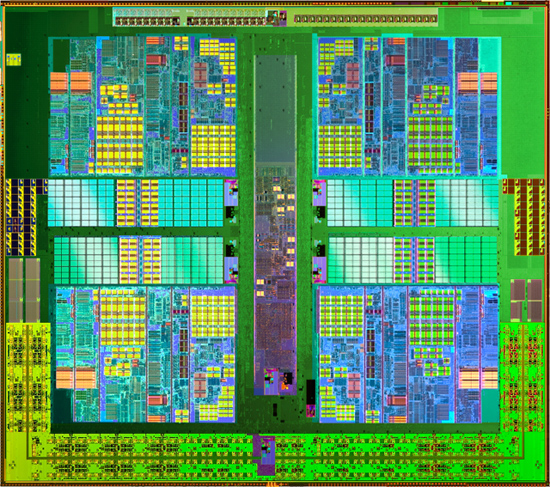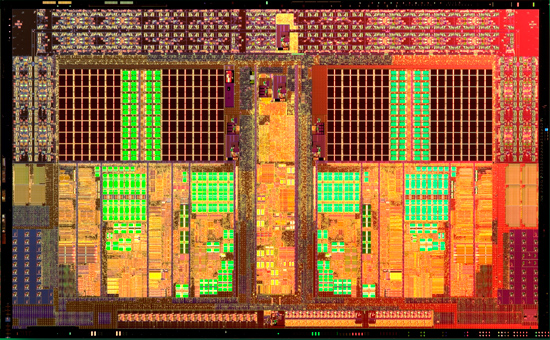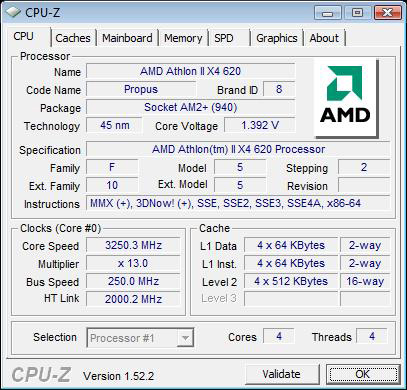AMD Athlon II X4 620 & 630: The First $99 Quad Core CPU
by Anand Lal Shimpi on September 16, 2009 12:00 AM EST- Posted in
- CPUs
How does AMD respond to Lynnfield? Is it by drastically cutting prices on Phenom II? Nope. By introducing the world’s first quad-core processor to debut at $99. Now that’s cool.

It’s called the Athlon II X4 and its existence shouldn’t be any surprise. AMD quietly announced it along with the Athlon II X2 line.

Today we get two models: the Athlon II X4 630 and the Athlon II X4 620, priced at $122 and $99 respectively. The only difference between the two is clock speed; the 630 runs at 2.8GHz while the 620 runs at 2.6GHz. These are both AM3 chips meaning they'll work in AM3 motherboards with DDR3 memory or AM2+ boards with DDR2 memory.
| Processor | Clock Speed | L2 Cache | L3 Cache | TDP | Price |
| AMD Phenom II X4 965 BE | 3.4GHz | 2MB | 6MB | 140W | $245 |
| AMD Phenom II X4 955 BE | 3.2GHz | 2MB | 6MB | 125W | $245 |
| AMD Phenom II X4 945 | 3.0GHz | 2MB | 6MB | 125W | $225 |
| AMD Phenom II X3 720 BE | 2.8GHz | 1.5MB | 6MB | 95W | $145 |
| AMD Phenom II X2 550 BE | 3.1GHz | 1MB | 6MB | 80W | $105 |
| AMD Athlon II X4 630 | 2.8GHz | 2MB | 0MB | 95W | $122 |
| AMD Athlon II X4 620 | 2.6GHz | 2MB | 0MB | 95W | $99 |
| AMD Athlon II X2 250 | 3.0GHz | 2MB | 0MB | 65W | $87 |

This isn’t a harvested Phenom II nor is it a pair of Athlon II X2s, instead it looks like we have a brand new die on our hands (some Athlon II X4s will be crippled Phenom IIs but AMD insists that the new die will be used). The Athlon II X4 has four cores on a single die, but unlike the Athlon II X2 each core only has a 512KB L2 per core. You can tell by the die shot that the core-to-cache ratio is much higher than on the X2:

The 45nm Athlon II X4 Propus die

The 45nm Athlon II X2 die (note the larger L2 per core)
Like the rest of the Athlon II lineup there is no L3 cache. This helps keep the die small (and affordable) but also hurts performance:
| Processor | SYSMark 2007 Overall | E-Learning | Video Creation | Productivity | 3D |
| AMD Phenom II X4 920 (2.8GHz) | 173 | 151 | 212 | 167 | 167 |
| AMD Athlon II X4 630 (2.8GHz) | 157 | 128 | 221 | 131 | 162 |
| % of Phenom II X4 | 91% | 85% | 104% | 78% | 97% |
At the same clock speed the Athlon II X4 should offer roughly 90% of the performance of a Phenom II X4.
| Processor | Cores | Manufacturing Process | L1 Cache | L2 Cache | L3 Cache | Die Size | Transistor Count |
| AMD Phenom II X4 | 4 | 45nm | 128KB per core | 512KB per core | 6MB | 258 mm2 | 758M |
| AMD Athlon II X4 | 4 | 45nm | 128KB per core | 512KB per core | 0MB | 169 mm2 | 300M |
| AMD Athlon II X2 | 2 | 45nm | 128KB per core | 1MB per core | 0MB | 117 mm2 | 234M |
| Intel Core 2 Quad Q8xxx | 4 | 45nm | 64KB per core | 4MB | 0MB | 164 mm2 | 456M |
The price is unbeatable. If we ignore the 630 for a moment, the Athlon II X4 620 is by far the cheapest route to four cores on the market. Intel’s most affordable quad-core is the Core 2 Quad Q8200 at $163, while AMD would previously charge you $163 for a Phenom X4 9600B. This is where the AM3/AM2+ compatibility play really helps out. Motherboard/memory costs are as cheap as possible thanks to AMD's incredible socket flexibility.

And just in case you’re wondering, yes, the Athlon II X4 620 actually delivers performance competitive with the Q8200 but for 60% of the cost. It’s not all that clear cut, there are some cases where the 620 is faster but others where the Q8200 is much faster. On average it ends up being a wash but you’ll want to pay attention to the coming pages to see how the cookie crumbles as it does vary from test to test.

Codename Propus
Overclocking isn't unfortunately as good as the Phenom IIs; the result of a conscious design decision or simply the early nature of the Propus die. That being said, without a single extra millivolt I was able to hit 3.25GHz on my Athlon II X4 620 sample - making it even more valuable. Extra voltage proved mostly useless, I could only approach 3.4GHz with an extra 300mV.
Let’s see, have I thoroughly ruined the surprise? Check. Now let’s get to the tests.
The Test
| Motherboard: | Intel DX58SO (Intel X58) Intel DX48BT2 (Intel X48) Gigabyte GA-MA790FX-UD5P (AMD 790FX) |
| Chipset: | Intel X48 Intel X58 AMD 790FX |
| Chipset Drivers: | Intel 9.1.1.1015 (Intel) AMD Catalyst 8.12 |
| Hard Disk: | Intel X25-M SSD (80GB) |
| Memory: | Qimonda DDR3-1066 4 x 1GB (7-7-7-20) Corsair DDR3-1333 4 x 1GB (7-7-7-20) Patriot Viper DDR3-1333 2 x 2GB (7-7-7-20) |
| Video Card: | eVGA GeForce GTX 280 |
| Video Drivers: | NVIDIA ForceWare 180.43 (Vista64) NVIDIA ForceWare 178.24 (Vista32) |
| Desktop Resolution: | 1920 x 1200 |
| OS: | Windows Vista Ultimate 32-bit (for SYSMark) Windows Vista Ultimate 64-bit |










150 Comments
View All Comments
damage98 - Saturday, November 21, 2009 - link
I have an asus m4n78 pro mobo. Would the new gt240 be appropriate?Thanks!
Archer0915 - Friday, September 25, 2009 - link
Well I have put it through the ringers and this is what I came upwith: http://www.techreaction.net/2009/09/25/athlon-ii-x...">http://www.techreaction.net/2009/09/25/...-x4-620-...
This thing can smoke or at least keep up with the common PhII or Core 2
monkeyman1140 - Monday, September 21, 2009 - link
I'm kinda iffy about how this compatibility thing works, and it seems manufacturers aren't terribly interested in compatibility bios updates either, preferring you to fork over fresh cash for the latest mobos.I'd like to put this in an older dual core system thats perfectly fine but its just not as fast as it used to be...
flexy - Friday, September 18, 2009 - link
What version of Cinebench R10 are you using?The 64 bit version or the 32 bit version?
G.
ClagMaster - Thursday, September 17, 2009 - link
Another well written article by Mr Shimpi on the latest AMD mainstream quad core offering. Article was brief and to the point with adequate benchmarking to support his claims. It's articles like this that keeps me coming back.The i5/P55 is the mainstream processor par excellance to acquire for a major upgrade if you presently have an Intel rig. This is what I am going to upgrade to next year because I have a 3 year old Intel rig. By that time, there will be 65W Lynnfields available with P55 boards thoroughly debugged.
However, if you have an AM2+ motherboard in good shape with a 780G/785G/790X/790GX chipset with continuing BIOS support, then the Athlon II X4 620 is an outstanding upgrade from dual to quad core for $100-$120. This is a really good value for bargain or mainstream. Price:Performance ratio is better than i5 just on the basis of the CPU alone. Throw in a paid-for motherboard into the equation and it gets even sweeter.
jtleon - Thursday, September 17, 2009 - link
Great Article Anand - as usual!Despite the other Intel Fanboy comments here, I take away from this that AMD is bringing Quad to the masses - and undercutting the competition at the same time.
Running an old Athlon XP as I write this, I am glad to see AMD resurrecting the Athlon name, and applying it to what may be their new bread & butter piece of silicon.
Clearly in a depressed worldwide economy, performance takes a backseat to price - AMD has an ace here with this design, in its 1st iteration, appears to have Intel over a barrel with regard to their inflated price structure. From the benchies here, the performance differences are almost imperceptible. Thus the Athlon II based boxes should jump off the shelves, leaving the other guys gathering dust.
Kudos to AMD - and Best of Luck on the next gen Propus.
jtleon
Genx87 - Thursday, September 17, 2009 - link
That X4 955 is being smoked for the most part by the i5 750. Intels basement i series processor. The i5 performs better, costs less, and consumes less power.Why cant AMD get their act together? Ever since Core 2 Duo they have been on the wrong end in a bad way.
the zorro - Thursday, September 17, 2009 - link
that's false.the results are biased because core i5 750 its overclocked at least 600 mhz.
phenom 955 beats core i5 750 clock by clock.
also when overclocked to 4 ghz core i5 temperatures are almost 100 C which is a failure.
also core i5 power consumption when overclocked skyrockets because of the integrated northdbridge.
Genx87 - Monday, September 21, 2009 - link
That is really irrelevant to the avg user is it not? The avg user doesnt care how the processor achieves it power\performance. Only that it does. That is a design feature of the Intel chips that isnt in AMD. Bottom line is in the suites and everyday use AMDs top processor is often beat by Intels next gen entry level chip.silverblue - Thursday, September 17, 2009 - link
Clock for clock? I don't think so. True, if the i5 didn't have Turbo, it wouldn't sprint ahead so far in single threaded applications, but the fact is it does and it's a legitimate technology. However, the 955 pulls closer, clock for clock, in multi-threaded tasks.The i5 ships with a rather weak cooler. It's not suitable for heavy overclocking... but then again, if you want to do it right, you'd get an after-market cooler anyway.
Nothing that AMD has out now is better clock-for-clock than Core2 or Nehalem, no matter how much we'd like to believe there is.